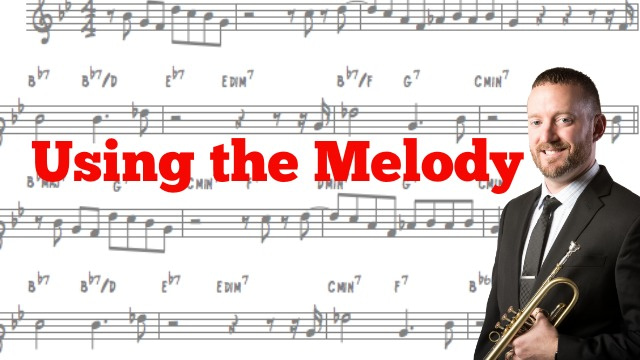Improv Tip Week #18-Using the Melody p1
Hey Everyone-here we are again with week #18’s tip-Using the Melody. This is the first week of another one of our multi-week series. If you’ve done any studying of improvisation in jazz, you’ll hear or read at some point the suggestion of “use the melody as your guide.” This is an excellent suggestion, especially for younger musicians or those just starting out in improvisation. However, I know for myself, no one really talked about how we’re supposed to use the melody as a guide. I had a few ideas of what it might be (like quoting the melody or using little phrases of the original melody in my improvisation), but never really had any ideas that clicked. The next couple of weeks, we’re going to look at how we can use the melody in our improvisations. The composer of the song we’re playing took the time to create the main theme or melody and we should be using it (or some form or part of it) while improvising. One of jazz education’s pioneers, Dr. Ed Byrne, has a lot of great material on using elements of the melody. This week’s tip is based off of his research and I recommend you check it out.
In my very first improv tip (week #1-Guide Tones/Targets), we looked at what guide tones or targets are and how they’re great notes to aim for in improvisation. We’re going to look at the melody and find it’s essential pitches. Many times, these essential pitches will be guide tones. However, many times the melody may not have a guide tone (3rds and 7ths) in a particular measure. We’re looking for essential pitches, or those that are most important to the melody…and sometimes those are 9ths, 11ths, 13ths, etc. Half notes or greater become obvious choices because they’re taking up harmonic space. If they’re less than a half note (quarters, eigths, etc) then I believe it’s up to the personal intrepretation of the improvisor to determine if it’s essential or not. The ears are the ultimate judge. We first determine what those essential pitches are and use them as targets for our improvisation. Depending on the harmonic progression, there can be multiple essential pitches.
After finding the essential pitches, we can use different tools to get us to our targeted notes (or essential pitches). For our first week, let’s look at a jazz standard and give some examples.
This first week we’re going to look at a standard that just about everyone in the jazz world knows (All the Things You Are). Below is the first 8 bars of this standard that we’ll be using.
The graphic below shows what I believe would be the essential pitches to ATTYA. You will notice that in the case of this song’s first 8 bars, the essential pitches happen to be guide tones.
Now that we know what our essential pitches are, I’m going to use them as notes that I’m targeting. If you go back through some of our past week’s tips, you’ll find a few different tools of what we can use to get these targeted/essential pitches. This is a very big part of my approach and you can find out more about how to creatively get to these pitches by checking out my book, Targeting: Improvisation With Purpose. Adding creative rhythm along with the tools to get us to our essential pitches creates an improvisation that’s based off of the melody. If you play the example below, you can still recognize the original melody.
I hope you’ve enjoyed this week’s tip. Over the next couple of weeks we’ll be looking at a few different standards and expanding what we can do to “use the melody as our guide.” Thank you again for checking this week’s tip out and I encourage you to share this tip (and blog) with your friends via Facebook, Twitter, LinkedIn, Google+ or any other music site that you’re a contributor. For more information on my book, Targeting: Improvisation With Purpose you can go to Jason Klobnak Music. Thanks again and I look forward to your thoughts/comments!
Thank you for taking the time to read this blog/post. As a thank you I wanted to give you a FREE MP3 from the JKQ. Simply click the button below and fill out the short form and you’ll have it in just a few short moments!






